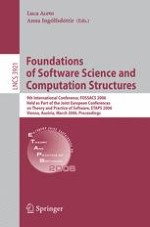2006 | Buch
Foundations of Software Science and Computation Structures
9th International Conference, FOSSACS 2006, Held as Part of the Joint European Conferences on Theory and Practice of Software, ETAPS 2006, Vienna, Austria, March 25-31, 2006. Proceedings
herausgegeben von: Luca Aceto, Anna Ingólfsdóttir
Verlag: Springer Berlin Heidelberg
Buchreihe : Lecture Notes in Computer Science
